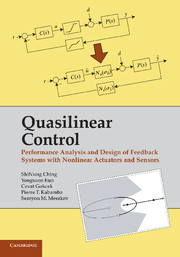 Quasilinear Control
Quasilinear Control Book contents
- Frontmatter
- Contents
- Preface
- 1 Introduction
- 2 Stochastic Linearization of LPNI Systems
- 3 Analysis of Reference Tracking in LPNI Systems
- 4 Analysis of Disturbance Rejection in LPNI Systems
- 5 Design of Reference Tracking Controllers for LPNI Systems
- 6 Design of Disturbance Rejection Controllers for LPNI Systems
- 7 Performance Recovery in LPNI Systems
- 8 Proofs
- Epilogue
- Abbreviations and Notations
- Index
- References
5 - Design of Reference Tracking Controllers for LPNI Systems
Published online by Cambridge University Press: 01 June 2011
- Frontmatter
- Contents
- Preface
- 1 Introduction
- 2 Stochastic Linearization of LPNI Systems
- 3 Analysis of Reference Tracking in LPNI Systems
- 4 Analysis of Disturbance Rejection in LPNI Systems
- 5 Design of Reference Tracking Controllers for LPNI Systems
- 6 Design of Disturbance Rejection Controllers for LPNI Systems
- 7 Performance Recovery in LPNI Systems
- 8 Proofs
- Epilogue
- Abbreviations and Notations
- Index
- References
Summary
Motivation: In designing linear feedback systems, tracking quality specifications are typically mapped into admissible domains in the complex plane and then the root locus technique is used to synthesize a controller that places closed loop poles in the desired locations. This methodology motivates the first goal of this chapter: to generalize the notion of admissible domains and the root locus technique to LPNI systems. Accomplishing this goal leads to a quasilinear method for PID controller design.
Overview: A technique for mapping the random reference tracking quality indicators, introduced in Chapter 3, into admissible domains on the complex plane is introduced (Section 5.1). Next, the root locus method for systems with saturating actuators is developed (S-root locus, Section 5.2). It turns out that the S-root locus is a subset of the usual root locus typically terminating prior to the open loop zeros. A method for calculating these termination points is provided. In addition, we equip the S-root locus with the so-called truncation points, which define its segments where tracking without amplitude truncation is possible.
Admissible Pole Locations for Random Reference Tracking
Scenario
In linear Control Theory, admissible domains for tracking deterministic references are defined using the classical “quality indicators,” that is, overshoot and settling, rise, and delay times. In this section, we develop a similar approach for tracking random references.
Information
- Type
- Chapter
- Information
- Quasilinear ControlPerformance Analysis and Design of Feedback Systems with Nonlinear Sensors and Actuators, pp. 134 - 166Publisher: Cambridge University PressPrint publication year: 2010